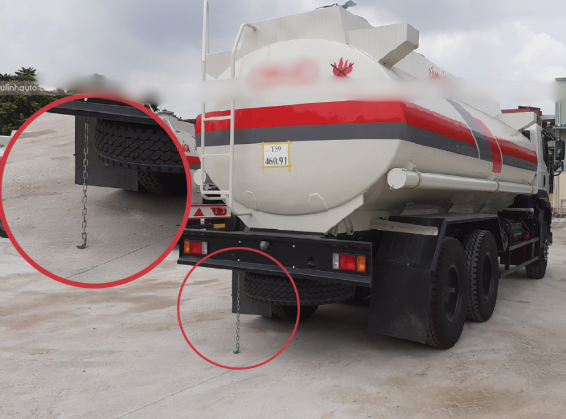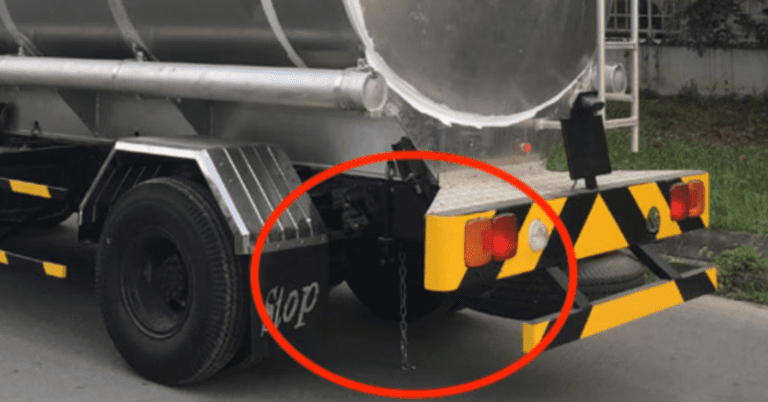Ever noticed an extra chain dangling from the back of a tanker truck? You might wonder why it’s there and what purpose it serves. It’s not just for decoration or as a backup hitch; it’s there for safety. This chain plays a crucial role in preventing a serious hazard—fires caused by static electricity. In this article, we’ll explore why tanker trucks have this extra chain, how it works, and why it’s essential for safe fuel transportation.
Understanding Static Electricity in Tanker Trucks

Tanker trucks transport highly flammable substances like gasoline and oil. When these trucks move, they interact with the surrounding environment in a way that generates static electricity. But what exactly causes this static build-up? Let’s break it down.
How Static Electricity is Generated Inside Tankers
When a tanker carries liquids like gasoline or oil, the liquid sloshes around inside the tank, coming into contact with the dry air inside. Simultaneously, the air inside the tank rubs against the tank walls, creating friction. This combination of moving liquid and air friction results in an imbalance of electric charges on the tanker’s surface, leading to static electricity.
- Movement of Liquids: The continuous sloshing of fuel or oil inside the tanker creates friction, leading to charge accumulation.
- Air Friction: As the tanker moves, air rubs against the metal surface of the tank, adding to the charge build-up.
- Charge Imbalance: This creates an imbalance, where static charges accumulate on the surface.
Static electricity might seem harmless, but it can be incredibly dangerous around flammable substances.
The Danger of Static Electricity in Tankers
Static electricity isn’t just a small inconvenience—it can be a significant hazard when transporting flammable liquids. Here’s why:
Risk of Fire and Explosion
Static electricity can ignite a fire, especially around flammable materials like gasoline and oil. If these accumulated charges aren’t discharged safely, they can result in a sudden spark. Imagine a situation where static charges reach a critical level and discharge in the form of a spark—this can ignite vapors around the tanker and cause a fire or explosion.
- Potential for Sparks: Static electricity can discharge through sparks, which are dangerous around flammable vapors.
- Fire Hazard: In an environment filled with flammable liquid fumes, even a small spark can result in a fire or explosion.
- Safety Measures: Preventing static electricity from reaching dangerous levels is crucial for ensuring safety during transportation.
How the Extra Chain Helps Neutralize Static Electricity
So, how does the chain help prevent these hazards? The extra chain on the back of a tanker truck serves a specific purpose: it provides a direct path for static charges to move safely to the ground.
Conductivity and Grounding
The extra chain is designed to be highly conductive. When the tanker moves, the chain drags along the ground, allowing static charges to be transferred directly to the earth. This process is called grounding or earthing.
- High Conductivity: The chain is usually made of metal, which has a high conductivity coefficient, making it ideal for directing electric charges.
- Neutralization: As the static charge builds up on the tanker, it travels down the chain and into the ground, where it’s safely dispersed.
- Continuous Discharge: The chain allows for continuous discharge, preventing the build-up of dangerous levels of static electricity.

This simple, yet effective solution ensures that the tanker remains electrically neutral, significantly reducing the risk of fire.
The Role of the Road Tanker Grounding System
The extra chain isn’t the only safety mechanism in place to manage static electricity. Another safety measure often used in conjunction with the chain is the Road Tanker Grounding (or Earthing) system, known as RTR.
How RTR Works During Fuel Transfer
When fuel is being transferred to or from the tanker, specialized grounding devices are used to ensure safety:
- Connecting Cables: Grounding cables are attached to the tanker and the fuel source to create a direct path for static discharge.
- Real-Time Monitoring: RTR systems often come equipped with sensors that monitor the grounding connection, ensuring continuous safety.
- Preventing Sparks: By maintaining constant grounding during the transfer, the RTR system ensures that any static charge generated during the process is safely neutralized.
This system provides an additional layer of protection, particularly during fuel loading or unloading, when static risks are heightened.
Why Chains and Grounding Systems Are Critical for Safety
While both the chain and the RTR system aim to eliminate static electricity, they do so in slightly different ways. However, both are crucial for tanker safety.
Static Management On the Move vs. Stationary Grounding

- The Chain: It works primarily when the tanker is moving, continuously discharging static charges that accumulate during transit.
- The RTR System: It’s most effective during stationary periods, such as when fuel is being loaded or unloaded, offering real-time monitoring and grounding.
Together, these systems create a comprehensive safety mechanism that significantly reduces the risk of fire and explosion.
A Simple Solution to a Complex Problem
Using a chain as a grounding tool might seem old-fashioned, but it’s actually a smart, cost-effective safety measure that’s still relevant today. It’s a classic example of how a simple solution can address a complex problem. By dragging along the ground, this extra chain continuously releases static charges, preventing them from reaching dangerous levels. Paired with modern grounding systems like the RTR, it provides a reliable defense against potential fires.
Conclusion: The Importance of Tanker Safety Measures
The extra chain at the back of a tanker truck is far from a trivial detail—it’s an essential safety feature designed to prevent static electricity build-up. By grounding excess charges as the truck moves, this chain helps avoid dangerous sparks that could lead to fires or explosions. Combined with advanced grounding systems used during fuel transfers, these measures create a safer environment for transporting flammable liquids. So, the next time you see a tanker truck with a chain trailing behind it, you’ll know it’s there for a good reason—keeping the journey safe, one link at a time.